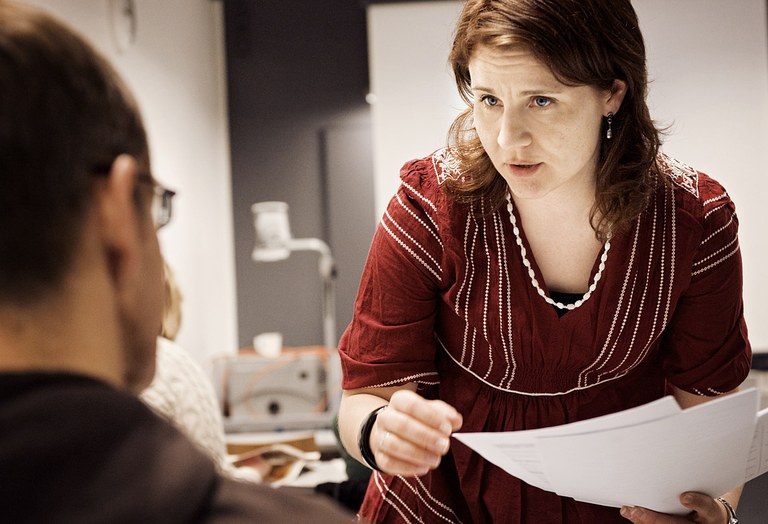Finland demands strong language skills
Finnish can be a difficult language to learn. Many immigrants have found out the hard way. To get a job you need very good spoken and written Finnish. It is crucial to invest in language skills in order to fully take part in Finnish society.
14 women and one lone man. This is the group practicing Finnish this morning at the Palmenia Centre for Continuing Education in Helsinki. Modality, phrases, temporal sentence structures and other challenges are tackled in the class room, and most of the students seem to have no problems whatsoever with the language course.
Teacher Nuppu Tuononen is going through the students' homework and begins by asking whether anyone had any problems with it. Clearly nobody did, as nobody answers.
Two of the women, Jarvnee Westerinen (33) and Fang Chen (39) are both married to Finnish men and came to Finland from Thailand and China. Both are trained economists and have accounting backgrounds.

Jarvnee Westerinen and Fang Chen
"Sometimes I despair," says Fang Chen about her language course, even though she lived and studied in Finland before going home to Shanghai to work. Now she is expanding her Finnish skills with book keeping and tax legislation terminology.
This summer both will do job training for an accountancy firm before continuing their language course in the autumn. There's a demand for accountants and most students who've attended this specialty Finnish course find work afterwards.
"But you need to know a lot of Finnish," says Jarvnee Palmenia, a service company owned by the University of Helsinki, specialises in language training for academics. Nuppu Tuononen says people from Estonia and Russia in particular reach an advanced level.
Ends too soon
Johanna Heimonen, responsible for language and culture education at Palmenia, says one problem is that the courses end too soon. When students reach basic levels B1 or A2 the course is no longer free and few immigrants are prepared to pay to learn Finnish. But their language is not good enough to find high-skill jobs which involve writing advanced texts in Finnish.
Heimonen feels demands should be eased, and this is an argument sometimes heard in the debate about why immigrants find it so hard to get a job. People who fail to master the language have a hard time making themselves understood, and colleagues are entitled to expect a good level of communication skills. On the other hand employers are known to demand perfect Finnish skills also when the work does not entail customer contact or advanced workplace communication.
"We're teaching academics and they want expert skills to mirror those they had at home," she points out and says their experiences have been good. Over a thousand academics have left Palmenia's language courses and entered the Finnish labour market.
All in one room
Johanna Heimonen's criticism of the language training which is organised outside of Helsinki is that immigrants are not put in different groups, but are all sat in the same classroom no matter their language level. When the Employment and Economic Development Office looks for language courses there's only one kind to be found. Nuppu Tuononen also says immigrants often find themselves on their own after learning Finnish, and that there should be some kind of support also when the course has ended.

Nuppu Tuononen
Around ten schools are responsible for language courses in Nyland regional council, home to Helsinki and a majority of Finland's immigrants. These courses include work experience too. Immigrants can also study Finnish or Swedish at some 30 other schools and institutions which offer parallel courses.
Immigrants make up only 2.7 percent of Finland's population compared to more than 14 percent in neighbouring Sweden. But with an ageing population and low birth rates there is a need for more immigration to fill positions primarily within the public sector and especially within the health sector. So the quality of the language courses is key for Finland's future.
New rules are currently being drawn up for the organisation of immigrant language training. In future the Employment and Economic Development Office's demands for course content will be binding and no longer just for guidance. The changes will be included in Finland's new integration law which comes into effect this autumn.
Lack of resources
Half of the country's immigrants live in the Helsinki region and many are waiting for a place at one of the language courses. There is not enough capacity. Kai Koivumäki, advisor at Finland's Ministry of Employment and the Economy, says financing is not a problem, but there is a lack of staff as a result of government cuts to the budgets of employment and economic development offices. Immigrants must have personalised integration plans before they can attend language courses. It is also important to allow language training to continue in the workplace. Few employers are prepared to give their workers time to study at work, but there are exceptions to the rule. The European Social Fund has provided finance.
"In Swedish Österbotten we have had ESF projects with tomato growers. But other employers do not want workers to study during working hours,” says Koivumäki, who envisages a future where projects are co-funded with the employers.
- Majority of Finnish language students are Russian
-
The latest statistics for immigrants in the Finnish labour market is from 2009. At the end of that year 51,000 people of foreign heritage applied for work and four in five were unemployed. The majority of job seekers came from Russia (12,900 people) and Estonia (6,300 people). Immigrants made up 6.4 percent of all job seekers. At the end of the year 14,400 immigrants were covered by integration programmes.

 Follow us on Facebook
Follow us on Facebook
